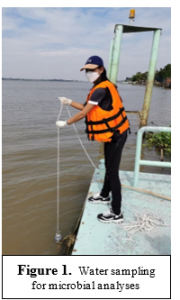Tracking sources of fecal pollution in water (Microbial Source Tracking)
![]()
Microbial Source Tracking (MST) methods for the detection of fecal pollution in water: Fecal contamination in water resources has become a problem of i ncreasing concern worldwide. Human pathogens and antibiotic resistant bacteria that are present in fecal material and wastewater can contaminate water and pose a risk to public health. However, current fecal pollution detection methods test for the presence of fecal contamination, but cannot distinguish what type of animal was the ultimate source. MST is an approach to identify fecal sources that contaminate bodies of water through the detection of enteric microorganisms that are specific to a particular host, such as humans, pigs, cows, goats, horses, or groups of similar animals, like ruminants and birds. By identifying the sources of fecal pollution, MST can greatly facilitate the management of polluted bodies of water, thus reducing public health risks and promoting environmental sustainability (Figure 1). The laboratory conducts research involving: the development of methods for measuring MST markers in laboratories and the characterization of different types of MST markers that can be used to identify specific sources of contaminants. These novel methods are then field tested in problem areas around Thailand. This involves the optimization of sampling techniques in the field and assessing the health risks of exposure to contaminated water. Ultimately, the research goals are to expand disciplinary knowledge and develop portable tools for field contamination detection.
Both culture-based and DNA-based methods are used for MST studies. Culture-based methods using bacteriophages, which are viruses that replicate inside specific bacteria, are being investigated for their use as host-specific fecal indicators. These phage-based methods are suitable for developing countries, because they are low cost and require no highly skilled technicians or complicated instruments. One of our publications on human sewage-specific indicators based on bacteriophages of Enterococcus faecalis was selected as the 2017 ACS Editors’ Choice in Environmental Science & Technology Journal (2021 impact factor of 11.357) and was featured on the cover (Figure 2). Moreover, our publication on the use of crass phage as a human fecal indicator using a DNA-based method had won the 2019 Best Papers for Environmental Science & Technology Letters Journal (2021 impact factor of 11.558). Overall, our continuous and systematic MST studies have been recognized by several achievements, including the 2022 National Research Award (first place) in the discipline of Engineering and Research Industry from the National Research Council of Thailand and the 2020 Japan International Award for Young Agricultural Researchers from the Ministry of Agriculture, Forestry and Fisheries of Japan.

Wastewater-based epidemiology (WBE) for detecting and monitoring factors affecting human health: WBE is the study of epidemiology through the analysis of wastewater for traces of infectious agents or chemicals/drugs of interest that have been circulating in population (Figure 3). For example, during the COVID-19 pandemic, WBE monitoring for SARS-CoV-2 RNA could be used to detect asymptomatic patients in communities and serve as an early or real-time warning of an outbreak. In Thailand, we firstly reported the applicability of monitoring for the RNAs of SARS-CoV-2 and its variants in wastewater using RT-qPCR assays for CDC N1 and N2 (Figure 4 ). This information could guide targeted prevention measures, such as increased vaccination or clinical testing access. Because one wastewater sample can represent a whole community, WBE approaches can reduce the number of samples, and associated costs and labor. WBE can support clinical surveillance for other emerging or reemerging infectious diseases in the future. In order to inform the public and governmental agencies, we developed “Guidelines for Surveillance of the Coronavirus Disease 2019 (COVID-19) Outbreak with Wastewater” in collaboration with the Department of Health, Ministry of Public Health, which has been distributed to Provincial Public Health Offices around the country.
![]()
Figure 3. Wastewater-based epidemiology (WBE)
for surveillance of disease circulation and chemical usage in
Figure 4. Interpretation and analyses of microbial genomic data



